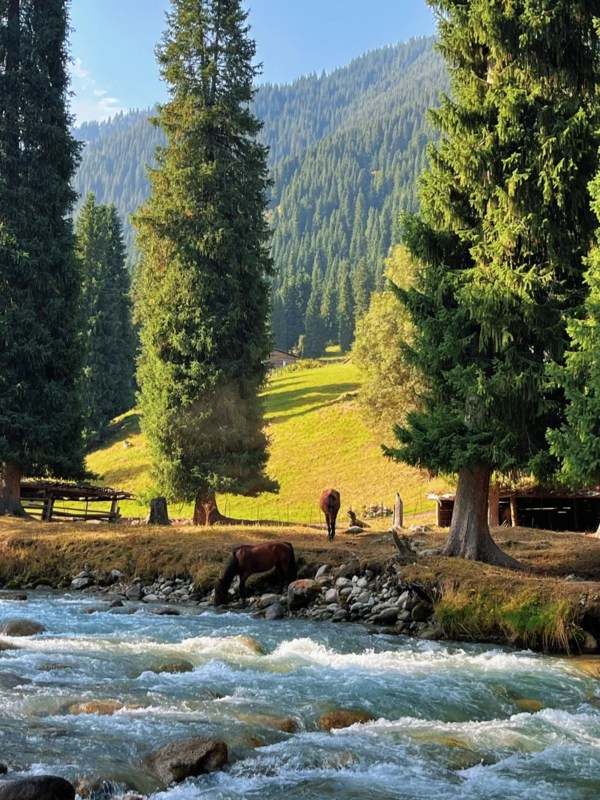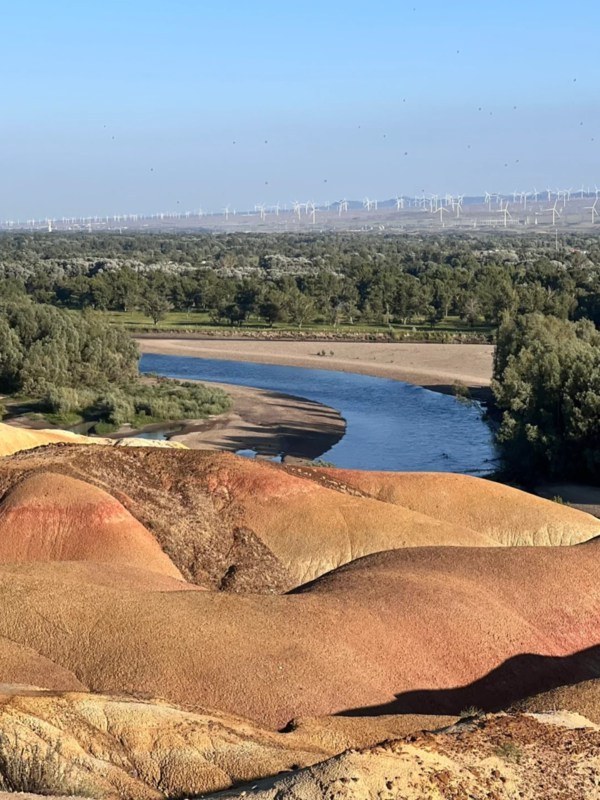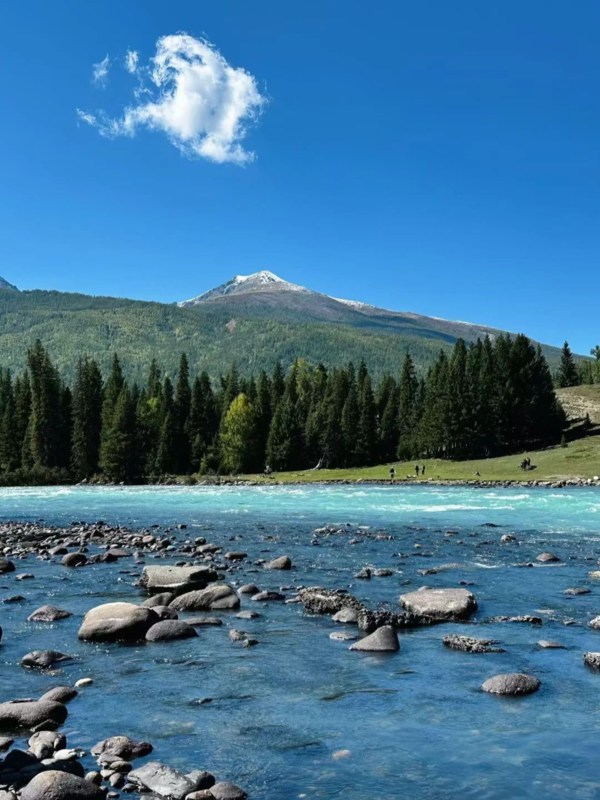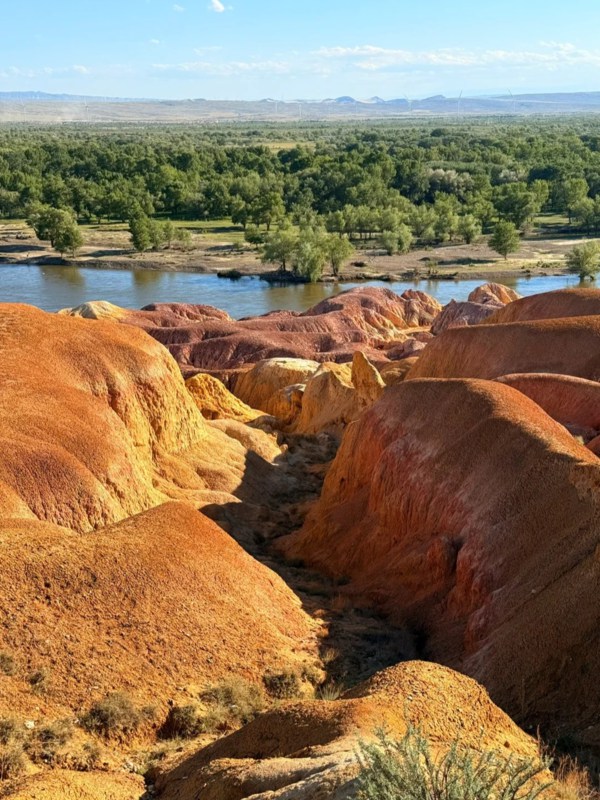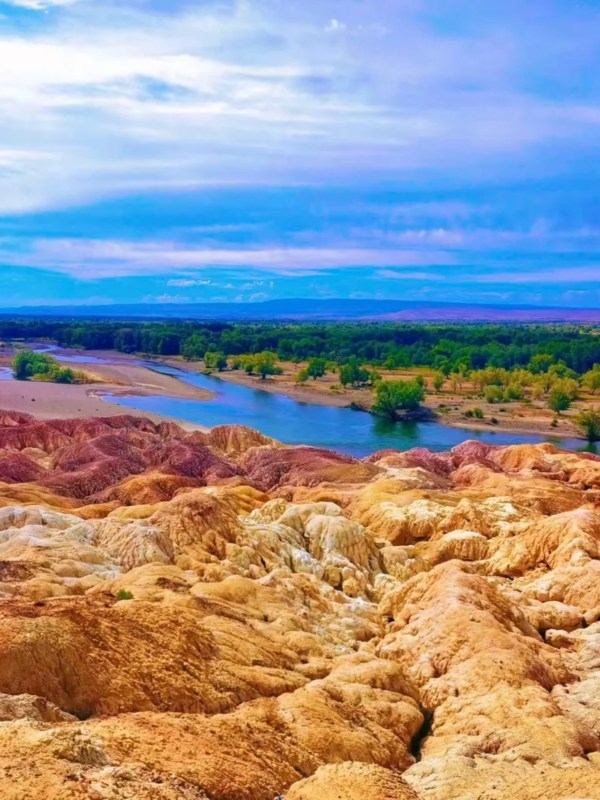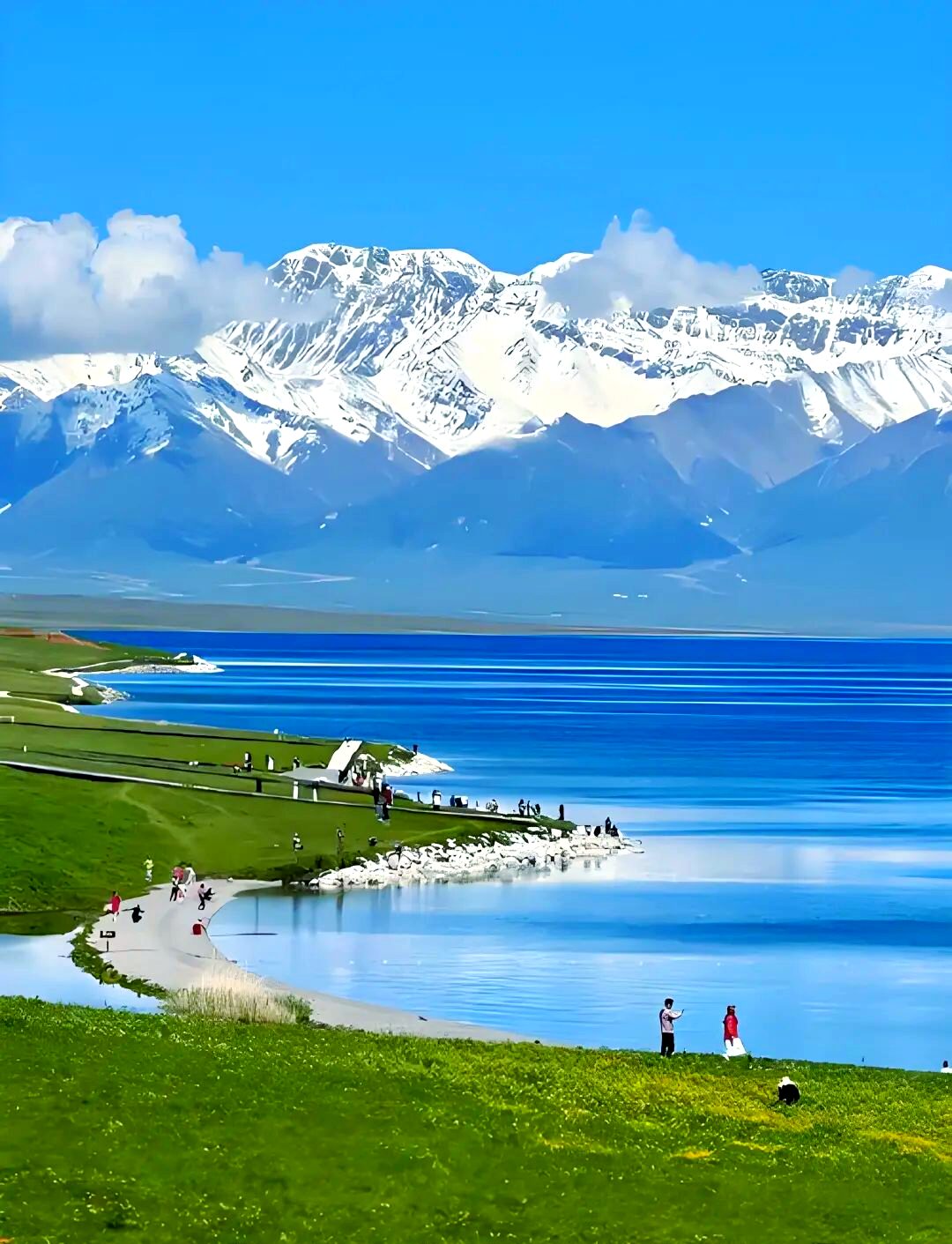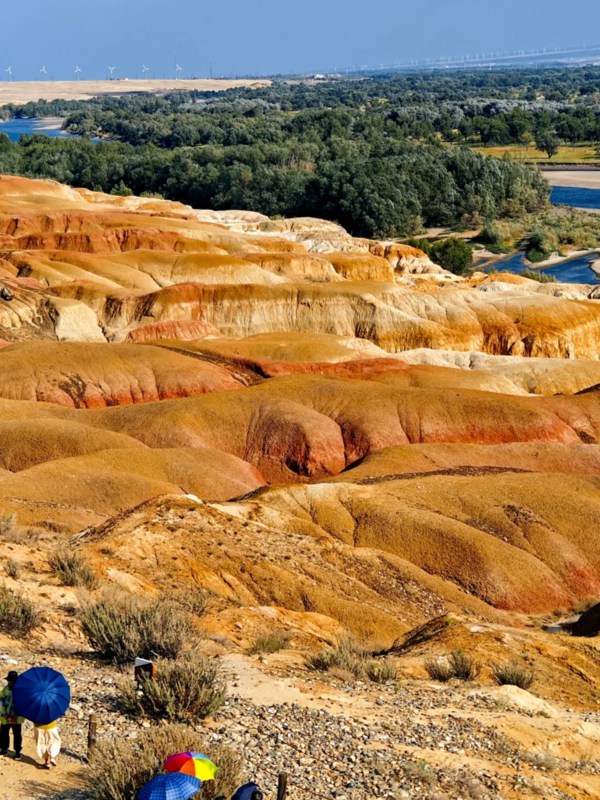
Five Colored Beach
The Five Colored Beach Keketuohai is located on the north bank of the Irtysh River, which is unique as it's the only river in China that flows into the Arctic Ocean. This area stands approximately 480 meters above sea level and lies along the route between Burqin and Habahe, making it an essential stop if you're traveling toward the main Kanas tourist region. Here, you'll observe a rapid transition from flat riverbeds to strikingly layered rock formations with distinct color bands.
This destination is particularly famous for its stunning sunset views, showcasing two contrasting landscapes along either side of the river—one lush and green, while the other is dry and textured. If you're planning a trip to northern Xinjiang and seek an easy hike with reliable photo opportunities, including Five Colored Beach Keketuohai in your travel plans would be both practical and rewarding.
Quick Facts about Five Colored Beach Keketuohai
| 📍 Location | five colored beach keketuohai on the north bank of the Irtysh River, between Burqin and Habahe |
| 🎫 Entrance Fee | ¥45–¥60 (varies by season; check Trip.com for updated rates) |
| 🌅 Best Time to Visit | Around 18:30–20:30 for sunset; autumn light is more stable |
| 🪨 Landscape Type | Eroded rock formations with layered mineral colors |
| 📌 Nearby Spots | Hemu Village, Kanas Lake, Urho Ghost City, Dushanzi Grand Canyon |
What Makes Five Colored Beach Keketuohai Feel So Otherworldly?
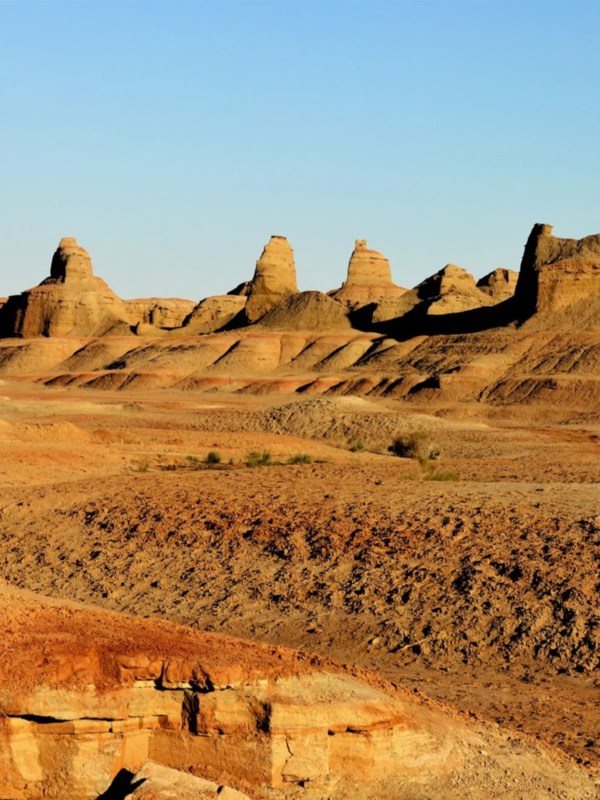
Urho Ghost City
A Landscape Born from Wind, Water, and Geological Tension
The landscape at Five-Colored Beach in Keketuohai forms through long years of erosion along the Irtysh River, where wind and water cut soft and hard rock layers at different speeds. This steady action creates uneven ridges, exposed mineral bands, and slopes that shift from purple to red to yellow depending on the iron and manganese within each layer. The river bends sharply here, and it constantly wears down the cliff edges, producing the stacked look seen clearly from the main viewing platform.
In sunlight these colors shift noticeably. Darker areas show older sediment compressed over long periods, while lighter zones come from newer layers shaped more often by wind. The Irtysh River adds a strong contrast, as its calm surface reflects against the jagged cliffs nearby, forming a scene widely linked to Five-Colored Beach in Keketuohai. There is no dramatic movement at first sight, yet stepping closer reveals fine geological details marked by cracks across the rock formations.
Why Travelers Keep Calling It “Xinjiang’s Rainbow Beach”
Users on TripAdvisor frequently share similar sentiments about this destination, using phrases like “unexpected colors,” “sunset magic,” and “quiet yet dramatic.” Many visitors are astonished by the vibrant hues presented in such a compact area, especially when the opposite shore appears rather plain. Some travelers note that the rock formations seem more vivid in person than in photographs, with the transition of colors between 6:30 PM and 7:30 PM being particularly surprising for newcomers.
Even when several tour buses arrive, many people observe that the atmosphere remains serene. The open terrain, gentle river breeze, and low sound levels make it easy to explore various viewing points. Due to its straightforward layout, numerous reviewers mention that this spot is ideal for those seeking a brief outdoor break without lengthy walks. These positive reactions contribute to the persistent use of the name “Xinjiang’s rainbow beach” online.
Comparisons with Urho Ghost City and Wucaitan
Urho Ghost City presents a harsher landscape characterized by wind-carved towers and loud gusts; conversely, Wucaitan is known for its smoother curves and softer shades. Positioned between these two styles lies Keketuohai five-colored beach. Its slopes appear washed by water rather than sculpted by fierce winds, resulting in distinct layers of color instead of a muddled appearance. Although smaller in size compared to others, Keketuohai colored beach benefits from its nearby river which enhances clarity and definition across the entire scene.
What to Do at Five Colored Beach Keketuohai: Trails, Viewpoints & Unexpected Quiet Moments
Where the Best Viewpoints Actually Are
The primary viewing platform is located on the upper ridge of the vibrant five-colored beach at Keketuohai, providing a sweeping view of the great river bend. The ground beneath your feet feels somewhat uneven, with loose gravel that shifts slightly when gusts of wind blow through. Many visitors tend to stay close to the railings, as this spot faces directly westward and showcases a stunning sunset around 7 PM when colors become more vivid. If you stroll ten or fifteen meters to your left, you'll notice a shift in perspective; the cliffs are positioned closer together, revealing richer purple shades.
Closer to the river lies a smaller viewpoint accessible via a sturdy wooden walkway that remains steady even on blustery days. This lower vantage point is ideal for capturing reflections in the Irtysh River. The light dances swiftly across its surface, leading to noticeable differences in color between the higher and lower viewpoints within just minutes. Although it’s quite basic, this two-tiered arrangement helps explain why many online comments compare this location to China's Rainbow Beach.
Walking Trails Along the Irtysh River
A short loop path meanders alongside the riverbank, allowing you to hear the gentle water lapping against the rocks. The Irtysh is distinctive in China since it flows northward toward the Arctic Ocean, and here, the current feels more stable compared to upstream areas. On calm days, you might spot a local fisherman tending to his nets at a shallow bend; while simple in design, these nets have served their purpose for many years.
In autumn, the small trees lining the river begin to change color early on. Some days, leaves suddenly transform into vibrant shades of yellow, creating a striking contrast with the darker sediment on nearby cliffs that looks almost artificially enhanced. The trail is mostly flat but has sections where sand accumulates underfoot, giving a unique feeling as you walk across it. Though not long in distance, this section along the river allows you to appreciate five-colored beach keketuohai from ground level instead of from above.
Side Trips: Hemu Village, Kanas Lake & Dushanzi Grand Canyon
Many visitors combine this area with other destinations around northern Xinjiang. Hemu Village is just a few hours away and attracts people with its cozy wooden cabins and morning mist. In a similar direction lies Kanas Lake; reaching it involves passing through Burqin town before ascending into mountainous terrain. If you want a deeper look before planning the detour, explore its highlights here — Kanas National Geopark Travel Guide 2025. Dushanzi Grand Canyon is located further south and often features in itineraries when travelers head back toward Urumqi.
These sites showcase various landscapes—Hemu offers tranquil valleys, Kanas boasts stunning alpine waters, and Dushanzi presents dramatic erosion formations. Together they create an appealing itinerary where five-colored beach keketuohai serves as an ideal midpoint—a brief stop connecting riverside views with mountain vistas and canyon explorations. This combination works well for those seeking diverse scenery without requiring extensive planning.
Where to Stay & What to Expect Around Five Colored Beach Keketuohai
- Baked Naan
- Lamb Skewers
Burqin Town—The Most Convenient Base
Many travelers stay in Burqin since it sits about 25 to 30 minutes from the colorful Keketuohai Beach and offers more dependable hotel choices. Mid-range hotels on Wenhua Road usually accept foreign passport holders for check-in, and the staff often switch to slower English or use translation apps, which keeps the process smooth unless it happens during a national holiday. Rates during the Kanas peak season range from ¥260 to ¥420 per night, and rooms fill up faster than many visitors expect.
The town has a compact layout, so guests can walk between restaurants and small grocery stores within a few minutes. Travelers wanting a quieter evening should avoid the main square on weekends, as music shows run late and fill the streets with louder sound. Staying in Burqin keeps access to the scenic areas simple, even when morning traffic increases more quickly during busy travel periods.
Food Around the Area—Simple but Surprisingly Good
Dining options near the river remain straightforward, which leads many visitors to head back to Burqin for dinner after exploring the colorful beach at Keketuohai. Standard Xinjiang fare is available, including lamb skewers, baked naan, milk tea, and fried noodles. I had a particularly memorable experience at a small eatery run by a Kazakh family on Jiefang Road where the naan was exceptionally warm and soft – likely pulled fresh from the tandoor just moments before serving. The owner communicated using a mix of Mandarin and Kazakh and relied on gestures to indicate which skewers were prepared that day. Though it was only a brief visit, it's one that stands out enough that I'll recommend it to friends.
For those seeking lighter options, several stalls along the riverbank offer yogurt and fruit during the afternoon hours. While these kiosks may appear temporary, their offerings are tasty and priced between ¥10–¥18. This uncomplicated food jives well with the laid-back atmosphere; it's not elaborate but definitely satisfying.
Safety Precautions, Signals, Tickets & Facilities
Wind is noticeably present in this scenic area, especially on higher platforms. Occasionally powerful gusts come from the west and can catch you off guard if you're standing near the edge; thus some caution is warranted when close to steep slopes due to loose debris overhead. There are signs advising against climbing down these slopes for safety reasons—a wise rule considering their unstable nature.
Mobile reception isn't consistent; while you might find good service near the main entrance, taking routes along lower paths often leaves you with minimal signal or none at all.
Restroom facilities are located close to ticket gates as well as another smaller unit near lower walkways. Ticket prices generally range from ¥45–¥60; staff members handle scans efficiently even during peak times. The pathways themselves are straightforward enough for easy navigation through Keketuohai's five colored beachesbut carrying an extra light jacket can be useful if breezes pick up unexpectedly.
Best Time to Visit Five Colored Beach Keketuohai & How to Read Its Light
- Summer of Five Colored Beach
- Autumn of Five Colored Beach
Sunrise vs Sunset: The Colors Don’t Behave the Same
Light changes the result at five colored beach keketuohai more than people expect. At sunrise softer tones move across the ridges, and some slopes glow pinkish before the sun rises fully above the horizon. The wind feels calmer in the morning, and one hears more sound from the river below, a long steady noise colder than the air. The sediment layers do not show the same brilliance at sunrise, yet the color contrast appears clearer, especially around the purple deposits near the lower bend.
Sunset acts differently. The light enters from the west and warms the ridge within minutes. Red areas grow deeper, and the yellow appears far more quickly. One can smell river moisture when the air cools again after twenty o’clock, and the wind grows stronger near the upper platform. Many published photos come from this hour, as the contrast with the Irtysh River grows much sharper. If anyone asks about the best time of the day to visit five colored beach keketuohai, he will receive sunset as the most reliable answer.
Seasonal Differences: Is North Xinjiang Worth It?
People often search “Is Xinjiang worth it?” or “Which is better, North or South Xinjiang?” The answer depends on your plans. Northern Xinjiang, north of the five colored beach keketuohai, stays cooler, especially during evenings, and the dry wind improves visibility on most days. Spring and autumn provide better working light for photography, and the cliffs hold their colors longer because the sun sits lower in the sky.
Summer brings stronger sunlight and larger crowds, although the long daylight helps people who prefer late-evening photos. In winter the place becomes quiet, but dust and snow weaken the colors, so photography becomes less effective unless you enjoy minimalist scenes. Northern Xinjiang fits travellers who want variety—rivers, canyons, forests—within short driving distances. South Xinjiang offers more desert scenery but remains less accessible. Both regions have value, yet Northern routes feel more flexible for a first-time visit.
When Crowds Hit—Avoiding the Tour-Bus Gap
The crowds come mainly at the time of the Golden Week, and season of crowds for Kanas. The tour buses generally arrive between 6 p. m. and 7 p. m., trying for the sunset. If you want quietness of space, it is better to get into keketuohai before 5 p. m. or after 7.30 p. m. The early morning is also empty, but the colors become softer. The change of timing therefore makes the experience at five colored beach keketuohai subjectively feel calmer, quieter and easier to deal with.
How to Reach Five Colored Beach Keketuohai Without Guesswork
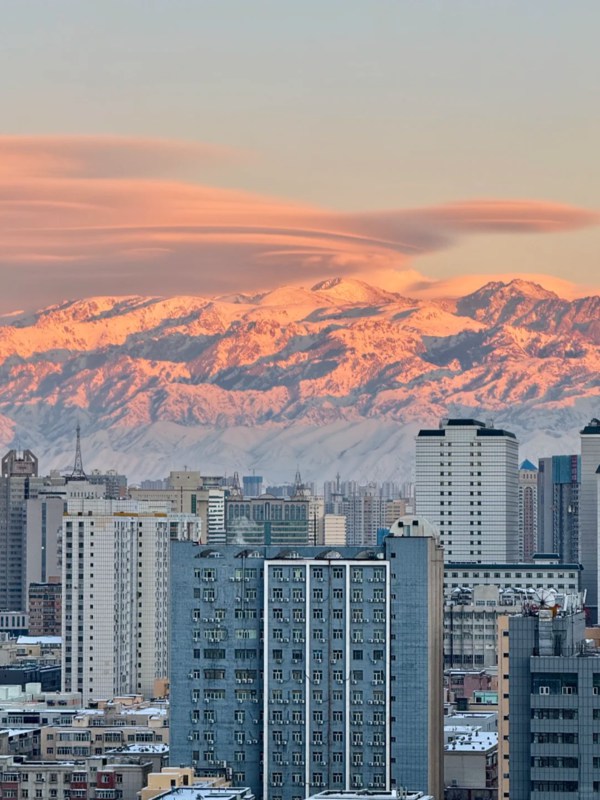
Urumqi
Getting There from Burqin or Kanas Lake
It takes about 25-30 minutes by car from Burqin to reach the colorful beach of keketuohai. The road most traveled takes one on the main road to Habahe. The road is paved, an easy drive, though the last few kilometers get a little bumpy. Taxis usually charge ¥60-¥90 one way, depending on the hour of the day and the mood of the driver.
If you are coming from Kanas Lake, expect a long ride of about two hours and a scarcity of filling stations along the way, so it is desirable to fill up in Burqin. And if you want ideas for other long-distance lake routes, you can check this detailed guide — Sailimu Lake Travel Notes 2025. The traffic is not serious except at the time of the main arrival of tourists to Kanas. The road signs are in Chinese, as well as in pinyin, so that navigation is not difficult.
Coming from Urumqi or Altay City
Travelers coming to Urumqi often change planes at Altay City and continue on to the scenic region. Altay Airport has small buses and automobile rental counters. Sometimes the help comes from employees using translation apps when talking with strangers. This way the system works even where one gets by on little Chinese. The trip from Altay takes about two hours, and about the same condition prevails of the road for much of the way.
A number of travelers prefer a full day of hire. This makes it easier and simpler for planning the method of reaching the five colored beach, keketuohai. The trip by auto from Urumqi takes a great deal longer, but the five hour flight, avoids many unnecessary detours. The getting to the region is not at all complicated, and requires only the rudiments of proper timing, and the advisable route for travel, and to enjoy to the fullest what the trip means.
FAQ About Five Colored Beach Keketuohai
Q: How long should I spend at Five Colored Beach Keketuohai?
Most travelers spend 40–70 minutes on-site because the walking paths are short and the viewpoints sit close to each other. If you want sunset photos, staying until 20:00 usually works. Families or self-drivers sometimes stay longer to walk along the river. The layout is simple, so exploring five colored beach keketuohai does not require a full half-day unless you prefer taking slow photos.
Q: Is Five Colored Beach in Keketuohai difficult to photograph?
Not really. The light changes quickly, but the angles are straightforward because the platforms face west. Tripods work on the upper deck, though the wind can shake lighter models. Colors appear stronger after 18:30, but the purple layers show better earlier in the day. Most first-timers say photographing Five-Colored Beach in Keketuohai feels easier than expected, as long as you check the sun direction.
Q: Can I combine Five Colored Beach Keketuohai with a trip to Kanas Lake?
Yes, and many travelers do it on the same day if they start from Burqin. The drive to Kanas takes roughly two hours and stays manageable except during peak season. Some visitors stop for 40 minutes at the scenic area before heading north. Combining both five colored beach keketuohai and Kanas Lake works best if you travel by hired car instead of public buses.
Q: Is the weather unpredictable in this part of Xinjiang?
The weather changes faster than most people expect. Clear skies can shift to cloudy in under an hour, especially near the river. Wind rises in the evening, and temperatures drop quickly after sunset. Still, conditions usually stay stable enough for photography. When checking forecasts for five colored beach keketuohai, expect small fluctuations rather than large storms unless it is early spring.
Q: What’s the road condition near Irtysh River in autumn?
Autumn roads remain dry and easy to drive, though the final stretch near the river has slight bumps. Visibility stays high thanks to cooler air and low dust. Bus traffic increases during Kanas season, so passing slower vehicles might take time. Drivers heading for the Irtysh bend or five colored beach keketuohai rarely face major problems unless they arrive during holiday peaks.
Q: What’s the best month for visiting Five Colored Beach Keketuohai?
Late August to early October gives the most stable light and fewer sand particles in the air. The cliffs show clearer color separation, and the river stays calm most afternoons. Summer works too, but crowds rise sharply. If you travel mainly for photography, visiting five colored beach keketuohai in early autumn gives the most predictable results without extreme temperatures.
Q: Is it worth hiring a local driver in Burqin?
For many travelers, yes. Local drivers know the quickest routes and can avoid slow sections where tour buses gather. Prices vary—usually ¥300–¥450 for a half-day—but the convenience helps if you are tight on time. Some drivers assist with photo angles or timing. Hiring one also removes the need to navigate directly to five colored beach keketuohai in unfamiliar light.
Q: Are drones allowed at Five Colored Beach Keketuohai?
Rules change occasionally. Some visitors report flying drones early in the day without issues, while others say staff asked them to register. Wind can be strong, especially on the upper ridge, making small drones unstable. If you plan to shoot aerial clips of five colored beach keketuohai, check recent visitor reports or ask the gate staff before takeoff to avoid misunderstandings.
